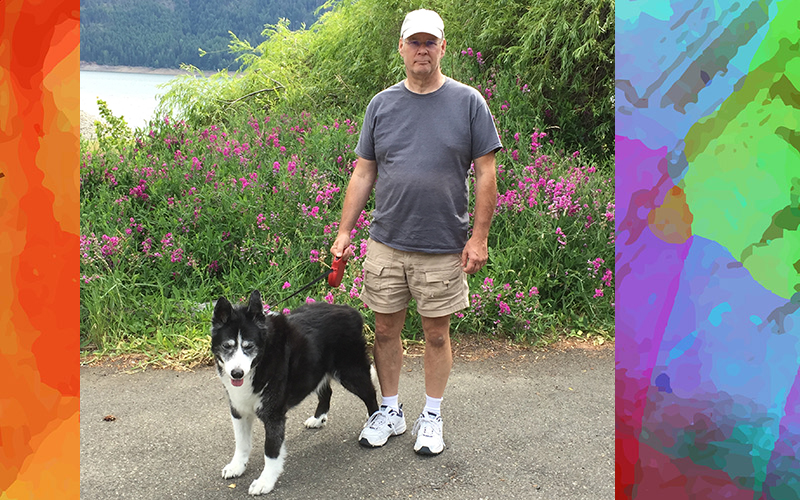
Waking up at 9 AM on August 31, Rick noticed he couldn’t move his right arm because it felt “asleep.” Using his left arm, he picked up his right arm to shake it and get the blood flowing, but that didn’t work. In fact, he couldn’t feel his right leg, see out of his right eye and “felt like a puppet with half my strings cut off.” Seeing her husband laying half on and half off the mattress, unable to stand or talk, Edith knew what had happened. As she called 9-1-1, Rick became disoriented.
This wasn’t Rick’s first health emergency. Sixty-three years old, with a history of heart attacks and severe heart disease, he was at high risk for stroke. The emergency medical technicians confirmed Rick’s stroke symptoms as they contacted Valley Medical Center to let them know they were on the way. Unable to comprehend the seriousness of his condition even though he was told it was a stroke, Rick remembers being in the ambulance, the sound of sirens and thinking that they didn’t need to drive so fast. During his transport, Valley’s stroke team was gathering, preparing for Rick’s arrival.
Time is brain
“Our mantra with stroke is ‘time is brain,’” says Jennifer Han, a Valley neurohospitalist. “The moment the medics recognize a stroke, they call the Emergency Department, kicking off a series of rapid notifications that go to emergency, radiology, and neurohospitalist teams who are ready and waiting for the patient to arrive for evaluation.” When Rick arrived, he received an immediate CT scan which confirmed a large vessel occlusion, a blood clot, in his brain.
Because Rick’s “wake-up” stroke took place at an unknown time during the early morning, he was unable to receive IV blood thinner treatment which can only be given within a defined, 4-hour window of a stroke occurring. However, because his stroke was reported within 24-hours, Rick was a good candidate for thrombectomy, the removal of the blood clot from a large vessel in the brain using a catheter. To save time, Valley interventional neurologist, Ali Sultan-Qurraie, MD called Edith as she was driving to Valley, clearly explaining the thrombectomy process he recommended for Rick and the blood flow risks involved.
Valley is now a certified Thrombectomy Capable Center
Before February 2020, stroke patients in Valley’s service area needing thrombectomy were transported to Harborview for the procedure, potentially causing further damage to the brain due to the time delay. In early February, Valley received its Thrombectomy Capable Certification after building the specialized surgical facilities and demonstrating the practices necessary to safely perform the procedure 24/7. This means that patients within our community now receive world-class neuro intervention for strokes much closer to home. Access to timely thrombectomy treatment improves patient outcomes, greatly reducing the likelihood of death and lasting disability.
“Every minute the brain is without oxygen, 2 million brain cells die” says neurologist Michael Previti, MD, Medical Director of Valley’s Stroke Center. “Twenty minutes delay of oxygen to the brain equals three months of disability. Our medics are great partners—Valley’s Emergency Department team works closely and collaboratively with them to keep improving processes into the future. Optimizing care for the community with quick, orchestrated responses from the entire team offers stroke patients the opportunity to live fully functional, capable lives. And when medics don’t have to drive stroke patients all the way to Harborview for thrombectomy, they are more available to support the next emergency.”
Miraculous surgery with miraculous recoveries
Following Rick’s thrombectomy, Edith arrived in Rick’s room in the Critical Care Unit and he was “normal.” Dr. Sultan told her as soon as he removed the blood clot, Rick started talking with only a slight delay in speech. Though most thrombectomy patients experience an initial 20% loss of motor function, Rick’s motor functions were restored with only a slight eye tracking issue which has since gone away. Dr. Sultan calls thrombectomy a “miraculous surgery with miraculous recoveries.”
Dr. Han agrees. “Rick’s brain was rescued from severe damage that would have left him unable to communicate or move his right side,” says Dr. Han. “As time is of the essence in acute stroke treatment, his remarkable recovery is testimony to the exceptional collaboration among a large care team acting very quickly.” Rick spent just two nights at Valley before walking out of the hospital on September 2 to return to his Covington home. The day after he was discharged from the hospital, Rick began receiving ongoing, comprehensive, follow-up care at Valley’s Neuroscience Institute Stroke Clinic to help prevent another stroke.
Semi-retired before his stroke, Rick resumed his part-time profession in real estate just a few days later. “My father had a stroke and lived with disabilities as a result,” says Rick. “I’m glad to not lose what I saw my dad lose. I’m thankful to be able to enjoy nature, go on walks, visit parks and drive. I’m so glad to still be alive and here for my wife, daughters and grandkids.”
Spot a Stroke FAST: Face drooping; Arm weakness; Speech difficulty; Time to call 9-1-1

